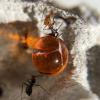So out of the colonies I have, C. sansabeanus is still not doing well. The few nanitics are alive, the queen is alive, there's a tiny handful of brood not developing, and nothing is going on. I have them on heat just like all the other colonies. You guys have told me C. sansabeanus doesn't need diapause/brumination, but they are acting kind of odd for that. The only other Camponotus I have are fragilis, who are doing well.
(I try giving them food but nothing really seems to happen. I even gave them a partially alive mealworm which got the queen to come out and bite it/sting it a few times, but that was it. Mealworm just sits there dead and no one touches it.)
I don't have a wine fridge. Garage is too warm (California). (I had them in there for a few weeks.)
Somewhere somewhere mentioned a brief cold shock can get queens laying again?
Or should I stick them in the kitchen fridge for a few months?
Any advice?
Edited by OhNoNotAgain, January 23 2020 - 2:37 PM.
















